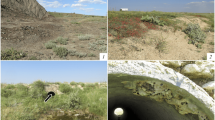Summary
By feeding131J mixed with a honey solution it was possible to label a colony ofLasius brunneus (LATR.) which is often a pest in buildings. Using a scintillation detector the distribution of the parts of the nest in an infested room could be determined. This was the precondition for a directed control. That method seems to be suitable also for a control ofMonomorium pharaonis (L.).
Similar content being viewed by others
Literaturverzeichnis
Bier, K.-H., 1956: Arbeiterinnenfertilität und Aufzucht von Geschlechtstieren als Regulationsleistung des Ameisenstaates. — Ins. Soc.3, 177–184.
Bier, K.-H., 1958: Regulation der Sexualität in den Insektenstaaten. — Ergebn. Biol.20, 97–126.
Brian, M. V., und C. A. H. Carr, 1960: The influence of the queen on brood rearing in ants of the genus Myrmica. — J. Ins. Physiol.5, 81–94.
Clausen, R., 1938: Untersuchungen über den männlichen Copulationsapparat der Ameisen, speziell der Formicinae. — Mitt. Schweiz. Ent. Ges.17, 233–346.
Gösswald, K., und K.-H. Bier, 1954: Untersuchungen zur Kastendetermination in der GattungFormica. — 4. Physiologische Weisellosigkeit als Voraussetzung der Aufzucht von Geschlechtstieren im polygynen Volk. — Ins. Soc.1, 305–318.
Gösswald, K., und W. Kloft, 1963: Tracer experiments on food exchange in ants and termites. Radiation and Radioisotopes Applied to Insects of Agricultural Importance, 25–42.
Hölldobler, B., 1962: Zur Frage der Oligogynie beiCamponotus ligniperda LATR. und Camponotus herculeanns L.(Hym. Form.). — Z. angew. Entomol.49, 337–352.
Kannowski, P. B., 1959: The use of radioactive Phosphorus in the study of colony distribution of the antLasius minutus. — Ecology40, 162–165.
Kloft, W., und B. Hölldobler, 1964: Untersuchungen zur forstlichen Bedeutung der holzzerstörenden Roßameisen unter Verwendung der Tracer-Methode. — Anz. f. Schädlingsk.37 163–169.
Mamsch, E., 1965: Regulation der Fruchtbarkeit von Ameisenarbeiterinnen ohne Königin und ohne „Königinsubstanz”. — Die Naturwissenschaften52, 168.
Passera, L., 1965: Inhibition de la ponte des ouvrières par les reines chez la fourmiPlagiolepis pygmaea LATR. — C. R. Ve. Congr. U. I. E. I. S., 293–302.
Stitz, H., 1939: In Dahl: Die Tierwelt Deutschlands 37.Hautflügler. I Ameisen oder Formiciden. Jena.
Rights and permissions
About this article
Cite this article
Buschinger, A., Kloft, W. Einsatz der Tracermethodik zur Lokalisierung von Nestzentren lästiger Hausameisen (Lasius brunneus LATR.,Hymenoptera, Formicidae). Anzeiger für Schädlingskunde 43, 49–53 (1970). https://doi.org/10.1007/BF02329979
Published:
Issue Date:
DOI: https://doi.org/10.1007/BF02329979




